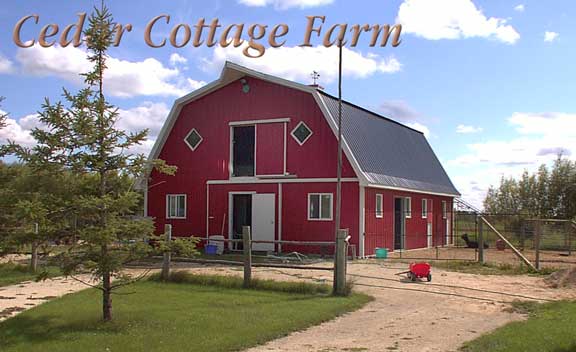 |
| FTLComm - St. Andrews (Manitoba) - August 9, 2000 |
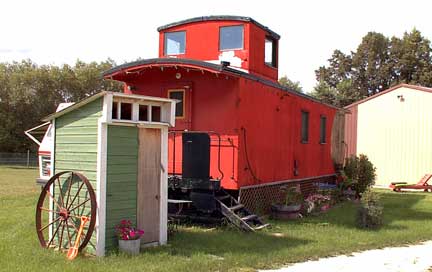 Wayne Sheldon and Dawn Dobbs live on their acreage Cedar Cottage Farms, North of Winnipeg, just North of the Selkirk airport. They enjoy the beautiful rural setting and some years ago had a couple of horses. In 1996 they acquired a couple of alpacas and the rest is history. The small herd has just grown and grown until now more than thirty amble around the farmsite. The farmyard layout says a great deal about the enjoyment the couple and their friends take in raising these interesting animals as this fully fitted out guest house caboose sits near the barn and hot tub. |
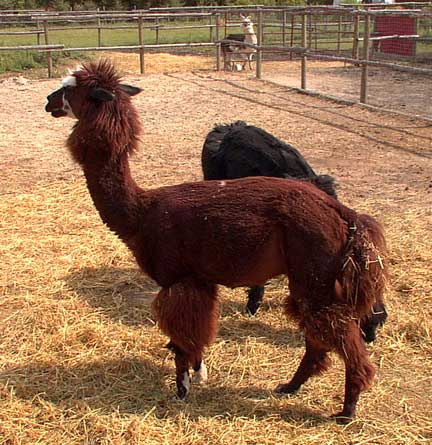 Dawn showed us around the farm and explained the complex social life of these Peruvian members of the Camel and Llama family. In this picture two males share with several others this large corral but in the distance you can see a fluffy gray and white male. He is in Dawn's bad books. As the dominant male of the flock he has enjoyed many privileges and all the other males with only a few exceptions are immature. (Alpaca males do not breed until they are three years old.) The guy in the distance was with the other males he got into a bit of a fight and Dawn wadded into the fray to sort things out and the bad guy made the mistake of taking a bite of Dawn. The result of his aggression is banishment. These animals were native to very cold climates and their marvellous hair is the reason they are raised as its microfibres are prized and can be woven into outstanding garments. In the warm summer of Manitoba |
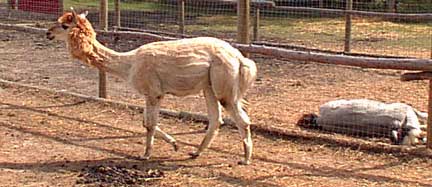 this great
insulating coat makes this great
insulating coat makesalpacas pretty uncomfortable so this is when their bodies are sheered. The fellow on the right has just been done and his head came out of the process a bit lopsided. The sheering is done by putting the animal on a rotating table that allows it to be swung from a standing position to a laying one for the hair cut to take place. The alpaca is strapped down to the table for its own safety. |
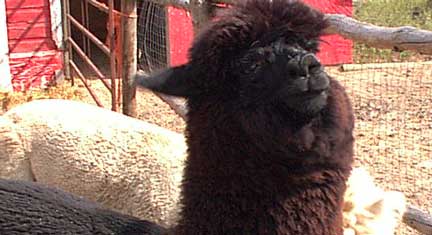 Farmers who have become involving raising alpacas talk of them with great affection and in only moments after you first meet your first alpaca you too will understand the charm these folks have. I am convinced that it is their human like faces and eyebrows that help us to identify with them and in turn assume character traits that we attribute to them. The two young males below are perfect examples of these expressive faces. The one on the left is showing his bottom teeth. Dawn pointed out that it is time to have these fixed. |
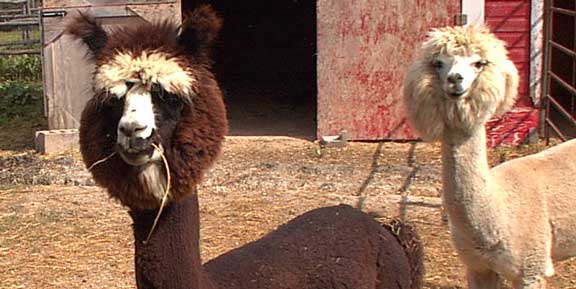 |
 In the wild, harvesting lichen and grass from mountainous country their teeth are constantly worn down, but in captivity with feed being provided to them the teeth just keep on growing and have to been trimmed regularly. As for feed the alpaca is not a picky eater and a mix of grass and clover seems fine with alfalfa pellets and a special feed mix in the winter. On the right are two elegant males, Fernando who's face is just off the picture is a very highly prized male as he has extraordinary hair that is most valued by alpaca farmers. |
 This is a group of females and some young arrivals. With a gestation period of ten months breeding takes place over the summer and fall and the babies show up in spring and early summer. The females are ready to be bred when only a year old. Notice the pens. Alpacas are fussy when it comes to bathroom habits and are almost automatically yard trained. The tend to select a spot in the middle of a pen or two or three spots in an open pasture and confine their droppings to that specific area. For the farmer it is excellent, a trip to the pile |
 with the wheelbarrow
and the with the wheelbarrow
and the yard is cleaned up in a flash. To show us a baby Dawn scooped up this three week old and carried into the barn for us to inspect. She explained that the sheering process is extremely confusing to the babies as mom after her summer hair do looks so different that it takes a while to realise that she is the same individual just with a new look. Though easy to care for and handle the alpacas are not like horses and dogs that crave and appreciate the affection of humans. Dawn described this as the alpaca being a bit stand-offish. Never-the-less it was pleasant to see how curious they were in us as visitors and hold relaxed they were. Like Llamas, when they get excited or frightened the alpaca will cough up stomach contents that are most unpleasant and "spit" Dawn explained that this was not a pretty thing to experience. But as for pretty this group of females below are all pretty |
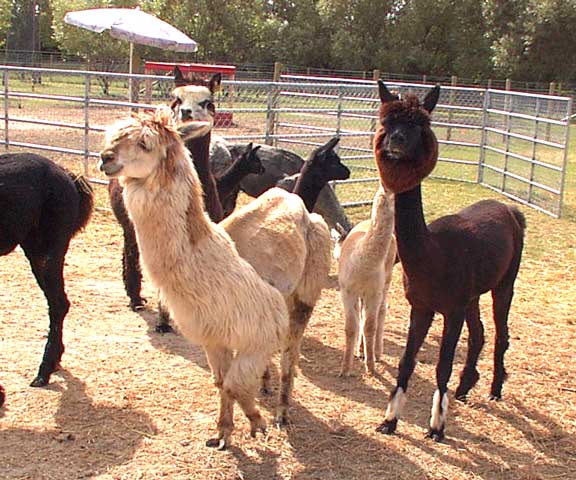 |
| Alpacas are extremely social animals but they do have their quirks. The individual in the pen shown below is one of the quirkiest. He shared his pen with two pigmy goats for some time and last winter the goats were moved elsewhere and this poor guy was beside himself. He paced up and down his pen complaining and vocallising his discomfort, he truly missed his buddies the goats. Dawn explained that the goats seemed fine without him but he was devastated. As a result of his protests they returned the goats to him and he is once again a happy alpaca. |
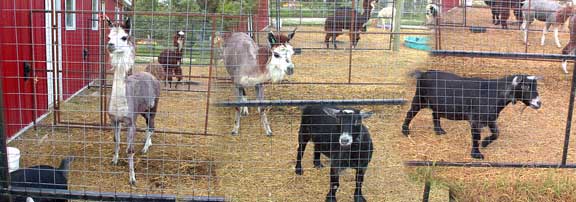 |
| As we stood around the pens and enclosures I kept hearing these humming sounds. I
asked Dawn what was going on and she explained that alpacas "hum". I said
that was because they didn't know the words but listening carefully indeed she was
right. Low long humming noises came from the calm animals. Below is the main herd of Wayne and Dawn's alpacas. Wayne said they really enjoy grass clippings and kept their pasture tidy and clean. He had been mowing some grass from the nearby area as they had far more fodder then even this group could consume. Wayne proudly pointed out that it would take eleven alpacas to consume the feed needed from this fields former resident, a horse. |
 |